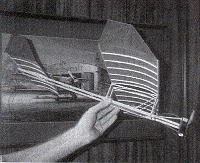What's |
INDOOR R/C | |
By Bob Aberle |
ALL ABOUT? | |
|
No longer the realm of the specialist, this facet of R/C modeling is now open to all with new designs and products, right off the shelf.
|

PHOTOGAPHY: BOB ABERLE Scale can also be part of indoor R/C, though speeds may increase. This little, scale Cessna CR-3 racer is sized to a GB-12 or a Brown A-23 CO2 motor. For so small a plane CO2 may be the lighter power option. The subject of flying model aircraft indoors is certainly not new. The AMA has held freeflight indoor events (rubber power, hand launched gliders, etc.) for as long as I can remember. Many have enjoyed this aspect of our hobby and, in fact, have specialized in it for years. A 184-page book, titled Indoor Flying Models, written by Lew Gitlow, provides excellent background material for indoor freeflight flying in general. Keep in mind that it does not cover R/C applications, but the model construction ideas presented are certainly worth having for reference purposes. This popular book is sold by Indoor Model Supply, Box 5311, Salem, OR 97304. Although freeflight flying indoors is a lot of fun, the addition of R/C can open a lot of new doors for the modeler who desires to get some flying time in while the snow is on the ground outside. Adding R/C to these models can make it possible to fly in relatively small indoor facilities. Not everyone can hope to have an airship hangar, with an 80-foot ceiling, as they have down at the Lakehurst NAS in New Jersey. But many school auditoriums, gymnasiums, with 20- to 25-foot ceilings, can accommodate some very practical indoor flying, if R/C is available to control or navigate the model around the facility. Indoor R/C is the subject of this special feature article. Its purposeis to provide as much current information as possible so that you too cantry this rapidly growing area of our model aviation hobby. Indoor R/C models are generally small in size, which makes them easier to build in a minimum amount of time, they are relatively inexpensive, can survive many flights without ever incurring much damage and are also easy to transport. Best of all, they can be flown usually under ideal conditions, without any care for wind, rain or any weather conditions for that matter. Just about the only concern you might have while flying indoors is an occasional draft caused by the opening of a door or a broken window pane. When you choose to go flying indoors--you will fly! What do you need to participate in Indoor R/C? The three basic ingredients to Indoor R/C are: (1) micro size reliable, lightweight and yet inexpensive R/C systems to control the model in flight; (2) micro size power systems to get the model in the air and keep it there for a reasonably satisfying period of time and (3) small, lightweight aircraft be they kits, published plans or even as we are now seeing ARF (Almost Ready to Fly) models that can now be purchased already built and covered, with little else necessary to do except install the motor and R/C system. We will get more into the details of this as the article moves along.
|



